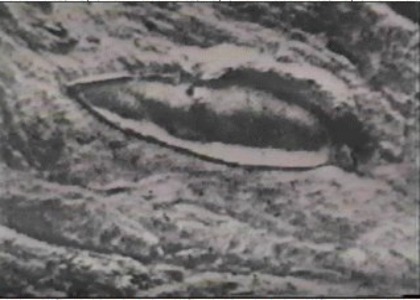KEEP WATCH
Ancient Discoveries on Trial
Part 3: Did Ron Wyatt find Noah's Ark?
Jim Allen

A Turkish army captain saw what appeared to be the remains of a large ship while flying over the mountains of Ararat in 1959. Soon after the discovery, he led a team of scientists to the site to investigate. The excavation results at the site were disappointing even though the boat-like shape with a rounded stern and pointed bow challenged their findings. But, this was not the end. Years later Ron Wyatt and his team went to the site and found so much archeological evidence that the government of Turkey was overwhelmingly convinced and declared the site a national park.
Scanning of the site by Wyatt's team of experts suggested the site had features mirroring a manmade structure. Even more remarkable, the dimension of the site is 300 cubits long, the same dimension given in the Bible for Noah's Ark (Genesis 6:15). Carbon testing of fossilized rock suggested its properties were once that of wood. The wood's laminated feature proved it was man-made. Reports from laboratory tests confirmed the artifacts found at the site were man-made metal parts used to hold the structure together. Wyatt claimed large stones found nearby were used to stable the ark in high winds. If true, the find would add credibility to Wyatt's claim.
Others disagree and claim the boat-like shape is a freak of nature. "Well-known creationist geophysicist Dr. John Baumgardner, a scientist at Los Alamos Laboratories…is known for his strong stand on the truth of Genesis. He researched the 'Ark-site' with Wyatt and eventually concluded the claims were 'bogus.'" [3.1]
Baumgardner's debunking of the site was surprising. When questioned further he said, "The footage of me in the video that has been shown several times on U.S. and British television during the last three years reflects my early enthusiasm about the possibility of a connection of the site with Noah's Ark, but it does not accurately represent my very firm conclusions reached after the extensive geophysical investigations we conducted at the site in 1987 and 1988. I realize this answer is brief, but I hope it is clear I am convinced the remains of the Ark must be somewhere else, that such remains are emphatically no associated with this boat-shaped formation." [3.2] Baumgardner went on to say he felt the site's formation was natural and not at all man-made.
So, what are we to make of these claims by Wyatt? Surely the Bible has something to say about this extraordinary vessel.
"In Genesis 6:14-15, God gave precise instructions about the dimensions of the Ark. 'Make yourself an ark of gopher wood; make rooms in the ark, and cover it inside and outside with pitch. And this is how you shall make it: The length of the ark shall be three hundred cubits, its width fifty cubits, and its height thirty cubits.' In the British Museum, a Royal Egyptian Cubit is 20.62 inches. By simple arithmetic, 300 cubits is equivalent to 300 x 20.62 inches = 6,186 inches. The length of the structure found by Ron Wyatt was 515.5 feet, which is 6,186 inches exactly! This seemed to confirm that this large vessel was indeed Noah's Ark. This was a very large ship, slightly smaller than the Titanic, and about the same size as a World War 2 Aircraft Carrier! The width was greater than that mentioned in the Bible as the sides of the boat had splayed, which would be expected in a ship of that age. The rib timbers and deck joists of the ship are clearly visible along the entire length of the ship." [3.3]
Is Wyatt right or wrong? What we know for sure is Noah built the ark to specific dimensions. The ark site found by Wyatt seems to match the dimensions, at least in length. While the width of the ship is not verifiable, it was recorded to be twice as wide because the sides, according to Wyatt, flayed out. The depth is not verifiable because the decks are said to have collapsed one atop another. Regardless, there is ongoing debate about the cubit measurement used by Noah.
"While the Bible tells us that the length of Noah's Ark was 300 cubits, its width 50 cubits, and its height 30 cubits, we must first ask, 'How long is a cubit?' The answer, however, is not certain because ancient people groups assigned different lengths to the term 'cubit' … The length of a cubit was based on the distance from the elbow to the fingertips, so it varied between different ancient groups of people." [3.4]
The irony of finding a geological site shaped like a large boat in an area of the world where the Bible said the ark landed is indeed credible. When you add the anchor stones found nearby and the onsite artifacts, the evidence weighs in Wyatt's favor. That there would be anything left of the ark is equally interesting, perhaps even a miracle for those unconvinced by the accuracy of the Bible and the claims of Wyatt.
Did Wyatt find Noah's Ark as claimed?
Page Two
3.1 Answers In Genesis — The non-Ark Site
3.2 Tentmaker — Letter from John Baumgardner
3.3 "Measurement and Confirmation of Noah's Ark in 1979"
3.4 Answers In Genesis — " How long was the original cubit?"
Ancient Discoveries on Trial: The Series
Part 1: Are the ancient discoveries by Ron Wyatt true or religious fraud?Part 2: Did Ron Wyatt find the Ark of the Covenant?
Part 3: Did Ron Wyatt find Noah's Ark?
Part 4: Did Ron Wyatt find the Red Sea crossing? — Coming Soon
Tags: Controversial-Issues | History-Apologetics
comments powered by Disqus
Published 2-5-14

